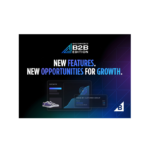When a giant asteroid hit the Earth and wiped out the dinosaurs, some malicious dinosaur-hating alien hadn’t sent it here. The real force responsible for the extinction-level impact was inertia. The asteroid hurtled through space, following the path set out for it by chance, never changing its course. It’s just physics; the Earth was simply in the wrong place at the wrong time.
Inertia can be just as deadly for B2B distributors as it was for dinosaurs. When you follow one path for a long time without trying to change, you miss opportunities for innovation and growth.
Unfortunately, sticking to the status quo is a widespread tendency in the distribution space. We often hear distributors say things like:
“Our customer service reps are order takers, not salespeople. They just aren’t comfortable pitching products during a call or email interaction.”
“Our sales reps are old school. Getting them to track their activities or use software for sales opportunities is like pulling teeth.”
“The way we do things works just fine. We don’t need to use artificial intelligence.”
But when we ask distributors what they would do if they could start over and build their business from scratch, innovation suddenly sounds a lot more appealing.
Would they intentionally hire customer service reps uncomfortable with upselling or cross-selling? No! Would they choose to bring on people who resist tech that could lead to major growth? Of course not!
It’s not that distributors think that innovation is a bad thing. It’s that inertia is an incredibly powerful force. We stick with what we know because it’s familiar and avoid what we don’t know because it’s scary. What if adapting for the future takes too much time, money, effort? What if you fail? Maybe the old ways aren’t working as well as they used to, but at least they’re still working. Kinda. Sorta. Maybe.
In this blog, we’ll explore how B2B distributors can challenge the status quo and embrace innovation to overcome inertia and propel their business in a bold new direction.
Inertia and “status quo bias”
In the business world, inertia comes from status quo bias—the belief that doing nothing is less costly, less risky and ultimately better than making a change. Unfortunately, the cost of maintaining the status quo can be steep in an economic reality where growth is paramount.
In his study “The Psychology of Doing Nothing,” research psychologist Christopher Anderson identified the four main origins of status quo bias:
- Preference Stability. You’ve made a big decision, and now your brain will do whatever it takes to justify it as the right one. Making another decision that takes you in a new direction feels like admitting defeat. For example, if you’ve had reactive reps for decades, making a change to have them proactively suggest products to grow wallet share instead of being order-takers is admitting your approach was ineffective all along. To avoid that unpleasant feeling, you do some mental gymnastics, such as equating the potential new direction to your existing direction, even if they’re on opposite sides of the compass.
- Anticipated Regret and Blame: You’re worried about failure, especially about receiving harsh criticism due to your decision-making. If you’ve been in charge of a failed implementation, you’re likely scared and worried about history repeating itself. Thinking about a bad outcome can feel just as bad as actually experiencing one, so you avoid all that unpleasantness by standing firm.
- Perceived Cost of Change: Holding onto the status quo feels like it’s “free,” while making a change feels expensive.
- Selection Difficulty: It’s also known as analysis paralysis. If your decision isn’t as clear as night and day, it’s a lot more comfortable to not make a decision than picking something that might not work out. For example, how do you select the right CRM when trying to decide between a CRM like Salesforce or Dynamics 365, widely used across various industries, or a vertical-specific CRM like Proton, built for distributors?
While many industries have been forced to leap into the future, distribution has managed to hang onto the status quo for decades without any drastic innovation. Change has come gradually, and so many leaders in the industry haven’t had much practice embracing radical new paths to growth and success.
However, with AI transforming all industries, including distribution, status quo bias and inertia pose significant dangers. Bill Gates said that AI is as revolutionary as the microprocessor, the personal computer, the Internet and the mobile phone. And according to McKinsey, early adopters of AI will increase cash flow by 122%, while followers will only gain 10% and late adopters may lose 23%.
Distributors need to get on board with AI before it’s too late
Here’s the thing, and it may be tough to hear: You don’t have much time left to make the right call on AI. Sales AI and AI-powered CRM tools already helping distributors:
- Grow wallet share by analyzing transaction history and finding opportunities to open new lines of business.
- Turn cost centers into profit centers by turning “order takers” into order makers. Customer service reps can upsell and cross-sell with AI setting them up for success.
- Remind reps to follow up with customers who are due to reorder certain products, ensuring their continued business before they slip away and start ordering from a competitor.
- Increase onboarding speed and effectiveness, making new reps productive in weeks, not years.
- Make it easier for new reps to know which customers to prioritize and which product pitches will likely lead to converted sales.
Distributors who have planted their flags in the new AI frontier are already seeing results, and there’s only so much land to go around. If you’ve hesitated to plant your own flag, we get it—worrying about the unknown is natural. Identify which of the four causes of status quo bias are holding you back and start working on changing it.
Big innovation doesn’t have to be an overwhelming change. Distributors who have implemented AI in their businesses, like R.S. Hughes, Benco Dental and ORS Nasco, started small with their AI roll-out. For example, they introduced the solution with a small subset of their sales team before rolling it out across the board or they deployed it in one area of business, such as eCommerce, rather than adopting all solutions at once.
Fight back against inertia
Inertia kills growth. If you can identify things you’d do differently if you had to build your distribution business from scratch, you can go through the pain and uncertainty of following a new path. Weigh the opportunity costs of waiting to embrace transformational technology against the risks of venturing into the unknown and start brainstorming steps to instill a culture of change in your organization.
Don’t be a dinosaur waiting around for the asteroid. Start building for a future with AI right now, and you’ll have a much better chance of being around for another eon or two.
Related Posts
-
The company says the latest release will enhance the online selling experience for suppliers, manufacturers,…
-
The decision to bypass wholesalers is the latest in a series of cost-cutting measures implemented…
-
HARDI distributors’ total sales growth in 2022 was 18.8%, according to the report.






